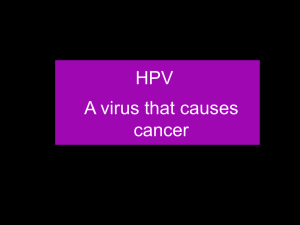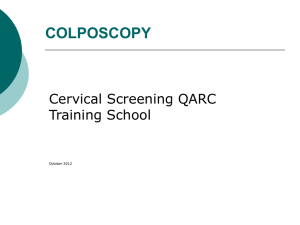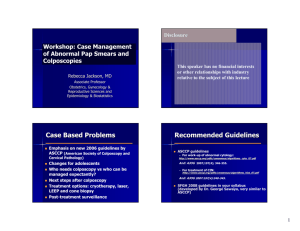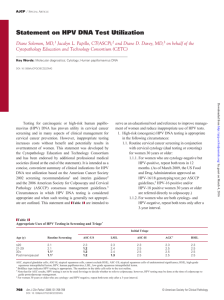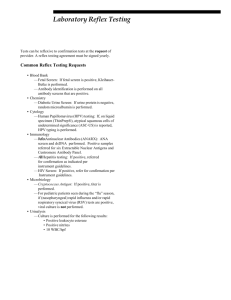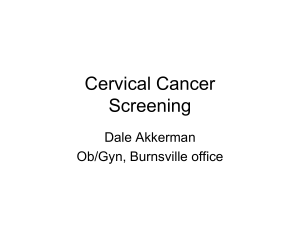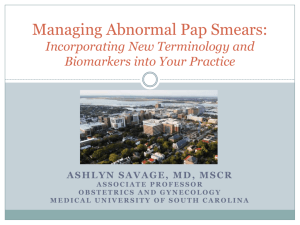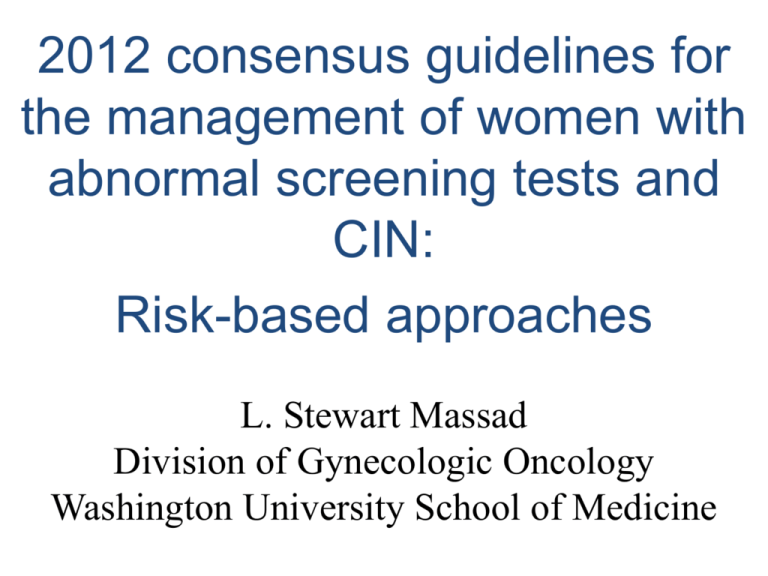
2012 consensus guidelines for
the management of women with
abnormal screening tests and
CIN:
Risk-based approaches
L. Stewart Massad
Division of Gynecologic Oncology
Washington University School of Medicine
Disclosures
• I have no financial ties to industry
• For reasons of time, sections on
AGC/AIS have been dropped.
– See www.asccp.org for algorithms and
supporting papers
Objectives
• At the conclusion of this session, participants
should be able to:
– Apply risk-based principles to the selection of
management options for women with abnormal
cervical cancer screening tests and CIN
– Individualize management for younger women at
lower risk
Goal of screening
• The goal of cervical cancer screening is
prevention of morbidity/mortality from
cancer
– Not finding CIN
– Not finding abnormal Paps
– Not finding HPV
• But prevention works via finding &
destroying cancer precursors, so we
target those surrogate endpoints
Limits to screening
• Attempting to prevent all cancer is unrealistic
and harmful
• Harms may include:
– Stigma, disrupted relationships, anxiety/distress
– Lost time, expense of investigation for lesions
destined to regress
– Pain, injury from colposcopy/treatment
– Pregnancy loss
2012 guidelines are risk-based
• 2012 guidelines based on "big data“
• Risk analysis of 1.4M women from KPNC
• >1M women age 30+ with cotesting
– 440 cancers, 3231 CIN3+, 7581 CIN2+
• Almost 400k women age<30 with cytology,
with HPV triage for ASCUS
– 26 cancers, 1231 CIN3+, 4193 CIN2+
Management follows risk
• High risk: treat by destroying TZ
• Low risk: routine screening
• Intermediate risk: manage by level of risk
– Short interval repeat cytology or cotest
– Molecular triage (HPV, genotyping, p16ink4a)
– Colposcopy with biopsy
• Definitions of high/low/intermediate risk are
based on community balancing of harms
from intervention vs risks of cancer
How to think about risk
• Risk of cervical precancer or cancer
condenses a battery of tests to one number
• The concept “Similar Management of
Similar Risks” ensures simplified,
consistent management of different test
combinations
• 2012 guidelines build off implicit risk
thresholds in prior guidelines
Benchmarking cotest risks to implicit 5-year CIN3+ cytology-only risk thresholds
Cytology-only 5-year CIN3+ risks
(implicit risk thresholds)
Current
management
based on
cytology-only
CIN3+
Cytology
result
SCC
HSIL
Immediate
colposcopy
(high-grade
cytologies)
Cotest 5-year CIN3+ risks
ASC-H
AGC
Frequency
risk
HPV/Cytology
result
HPV+/ HSIL
0.20% 50%
HPV+/ AGC
0.05% 34%
HPV-/ HSIL
0.01% 29%
HPV+/ ASC-H
0.12% 25%
HPV-/ ASC-H
0.05%
3.8%
HPV-/ AGC
0.16%
1.1%
1.1%
6.8%
HPV+/ LSIL
0.77%
6.2%
HPV+/ Pap-
3.5%
4.5%
HPV-/ LSIL
0.18%
2.1%
1.8%
0.45%
92.1%
0.08%
0.20% 48%
ASC-US
0.21%
8.7%
0.92%
2.7%
5.3%
2.6%
HPV-/ ASC-US
3-year return
Pap5-year return
• Left side orders risks
from all cytologies,
banded by current
management guideline
0.17% 18%
Immediate
Colposcopy
1-year return
CIN3+
risk
0.01% 83%
HPV+/ ASC-US
LSIL
Frequency
Summary:
Management by 5y
CIN3+ Risk Thresholds
95.8%
• Right side orders risks
for each co-test into the
risk band
• Managing cotest results
by these benchmarked
implicit risk thresholds
ensures “Similar
management of similar
risks”
0.26%
HPV-/ Pap-
Katki H et al. JLGTD 2013;17:S28-S35
Changes from 2006 guidelines: I
• Cytology negative/lacking endocervical cells
can be managed without early repeat.
• CIN 1 on endocervical curettage should be
managed as CIN 1, not as +ECC.
• Unsatisfactory cytology requires repeat even if
HPV negative.
• Genotyping triages HPV+/16-18+ women to
colposcopy only after negative cytology
– Colpo indicated for all women with HPV+ ASC-US,
regardless of genotyping result.
Changes from 2006 guidelines: II
• For ASC-US cytology, immediate colposcopy is
not an option.
– Serial cytology option for ASC-US incorporates
cytology at 12 months, (not 6 & 12months)
– Then if negative, cytology every 3 years.
• HPV- ASC-US results should be followed with
co-testing at 3 years rather than 5 years.
• HPV-negative and ASC-US results insufficient to
allow exit from screening at age 65 years.
Changes from 2006 guidelines: III
• The pathway to long-term follow-up of treated
and untreated CIN 2+ is more clearly defined by
incorporating co-testing.
• More strategies incorporate co-testing to
reduce follow-up visits.
– Pap-only strategies now limited to women <30yo,
but co-testing is expanded even to women younger
than <30yo in some circumstances.
• Women aged 21-24 years are managed
conservatively.
2012 ASCCP guidelines
Unsatisfactory cytology
• Accounts for <1% of all Paps
• With liquid-based cytology, usually results from
hypocellularity
• Some HPV tests lack squamous cellularity
control, so neg result is unreliable with unsat
• CIN3+ risk after HPV+/unsat cytology is unclear
Unsatisfactory Cytology
HPV unknown
(any age)
HPV negative
(age ≥30)
HPV positive
(age ≥30)
Either is acceptable
Repeat Cytology
after 2-4 months
Colposcopy
Abnormal
Manage per ASCCP
guideline
Negative
Unsatisfactory
Routine screening (HPV-/unknown) or
Cotesting @ 1 year (HPV+)
© Copyright , 2012, American Society for Colposcopy and Cervical Pathology. All rights reserved.
Pap neg but no EC/TZ component
• Occurs in up to 10-20% of Paps
• Missing endocervical/metaplastic cells
• Since most cancers arise near SCJ, not clear if
all areas at risk were sampled.
• But risk for CIN3+ is NOT greater in follow-up,
indicating lesions not missed.
• HPV results independent of TZ sampling
– Neg result has good NPV
Cytology NILM but EC/TZ Absent/Insufficient
Age ≥30 years
Ages 21-29*
HPV negative
HPV unknown
or
HPV testing
(Preferred)
Repeat cytology in 3
years (Acceptable)
HPV positive
or
Cytology+ HPV
test in 1 year
Routine screening
Genotyping
Manage per
ASCCP guideline
*HPV testing is unacceptable for screening women ages 21-29 years
© Copyright , 2012, American Society for Colposcopy and Cervical Pathology. All rights reserved.
Cytology negative, HPV positive
•
•
•
•
•
Occurs in 5-10% of cotests among women 30-64
CIN3+ risk is higher than after Pap-/HPV- result
But CIN3+ risk insufficient to justify colpo for all
Risk is increased if HPV positivity persists
Women with HPV 16/18 are at particularly high
risk of CIN3+ despite neg Pap (≈10%)
– HPV18 linked to adenocarcinoma, sometimes missed
by Pap alone
Management of Women ≥ Age 30, who are Cytology Negative, but HPV Positive
Repeat Cotesting
HPV DNA Typing
@ 1 year
Acceptable
Cytology Negative
and
HPV Negative
Acceptable
≥ASC
HPV 16 or 18 Positive
HPV 16 and 18 Negative
or
HPV positive
Colposcopy
Repeat Cotesting
@ 1 year
Repeat cotesting
@ 3 years
Manage per
ASCCP Guideline
Manage per
ASCCP Guideline
© Copyright , 2012, American Society for Colposcopy and Cervical Pathology. All rights reserved.
Managing ASC-US
• Reported in about 5% of all Pap tests
• 33-66% are HPV-associated
– HPV testing about 95% sensitive for CIN2+
– Specificity roughly doubled to >60%
– HPV+ more often in younger women (>60% if <25yo
but <25% if 45-55yo), those with more partners
– HPV triage of ASC-US more cost-effective than
repeat cytology
Arbyn M et al Vaccine 2006;24:S3:78-70
Eltoum IA et al Cancer 2005;105:194-99
Managing ASC-US
• Removal of ASC-H from ASCUS in 2001 Bethesda
revision decreased CIN3+ risk
– CIN3+ risk after ASC-US in KPNC < risk in ALTS
• For women >60yo, cancer risk after HPV- ASC-US
>> after HPV-/Pap– Requires retesting in <5y (contrast 2011 screening recs)
• CIN3+ risk for HPV+, 16/18- ASC-US requires colpo
Risk among
women 30-64
Katki H et al. JLGTD 2013;17:S36-42
Cancer risk after ASC-US
vs neg cytology among
women 30-64:
Note higher risk among
60-64yo women. This
was confirmed in women
>65yo, leading to
recommendation to
continue screening after
HPV- ASC-US—not
considered neg to allow
exist from screening
Katki H et al. JLGTD 2013;17:S36-42
Management of Women with Atypical Squamous Cells
of Undetermined Significance (ASC-US) on Cytology*
Repeat Cytology
HPV Testing
@ 1 year
Acceptable
Negative
Preferred
HPV Positive
> ASC
HPV Negative
(managed the same as
women with LSIL)
Routine
Screening
(Cytology in 3 years)
*Management options may vary if the
woman is pregnant or ages 21-24.
Colposcopy
Repeat Cotesting
@ 3 years
Endocervical sampling preferred in women
with no lesions, and those with inadequate
colposcopy; it is acceptable for others
Manage per
ASCCP Guideline
© Copyright , 2012, American Society for Colposcopy and Cervical Pathology. All rights reserved.
Managing women 21-24
• Risk of cancer remains low (about 2/million)
• In KPNC dataset, only 3 cancers in 133,947
women 21-24yo
– One cancer in 11,280 with ASC-US (HPV+)
– No cancers in 4,810 with LSIL
• HPV risk is peaking
• Likelihood of future conception is high
• Most CIN2 that is found will regress
LSIL among women ages 21-24
• 5y CIN3+ risk only 3% after ASC-US & LSIL
• 5y CIN3+ risk only 4% after HPV+ ASC-US
– Both significantly lower than for older
women
• 5y CIN3+ only 0.6% after HPV- ASC-US
– Compare risk of 0.2% after neg Pap
Low risk when HPV+/- means HPV triage
alters management minimally: not required
Management of Women Ages 21-24 years with either Atypical Squamous Cells of
Undetermined Significance (ASC-US) or Low-grade Squamous Intraepithelial Lesion (LSIL)
Women ages 21-24 years with ASC-US or LSIL
Repeat Cytology
HPV Positive
@ 12 months
Preferred
Negative, ASC-US
or LSIL
ASC-H, AGC, HSIL
Reflex HPV Testing
Acceptable for ASC-US only
HPV Negative
Repeat Cytology
@ 12 months
Negative x 2
> ASC
Colposcopy
Routine
Screening
Routine
Screening
© Copyright , 2012, American Society for Colposcopy and Cervical Pathology. All rights reserved.
Managing LSIL
• 2-3% of cytology specimens
• LSIL and HPV+ ASC-US have similar CIN3+ risks
and clearance rates
• About 75% are HPV+
– Too many for efficient HPV triage
• However, when HPV- LSIL obtained in women
30-64 at cotesting, 5y CIN3+ risk is only 2%
• 67% have CIN1/HPV effect at colposcopy
• Risk of cancer is <0.5% after LSIL
Risks after LSIL
in women 3064yo
Katki H et al.
JLGTD
2013;17:S43-49
Management of Women with Low-grade Squamous Intraepithelial Lesions (LSIL)*
LSIL with no HPV test
LSIL with negative HPV test
LSIL with positive HPV test
Preferred
Acceptable
Colposcopy
Repeat Cotesting
@ 1 year
≥ASC
Non-pregnant and no lesion identified
Unsatisfactory colposcopic examination
Satisfactory colposcopy and lesion identified
or
Cytology Negative
HPV positive
and
HPV Negative
No CIN2,3
Repeat Cotesting
Endocervical sampling “preferred”
Endocervical sampling “preferred"
Endocervical sampling “acceptable”
CIN2,3
@ 3 years
Manage per
ASCCP Guideline
Manage per
ASCCP Guideline
* Management options may vary if the woman is
pregnant or ages 21-24 years.
© Copyright , 2012, American Society for Colposcopy and Cervical Pathology. All rights reserved.
Managing ASC-H
• Found in 0.5% of cytology specimens
• CIN3+ risk at 5y = 18% among women 30-64
• >60% are HPV+
– HPV triage relatively inefficient
– CIN3+ risk when HPV- = 3.5% at 5y
– CIN3+ risk when HPV+ = 25% at 5y
Risk after ASC-H is intermediate between ASC-US/LSIL & HSIL
Katki H et al. JLGTD 2013;17:S28-S35
Management of Women with Atypical Squamous Cells: Cannot Exclude
High-grade SIL (ASC-H)*
Colposcopy
Regardless of HPV status
No CIN2,3
Manage per
ASCCP Guideline
CIN2,3
Manage per
ASCCP Guideline
* Management options may vary if the woman is
pregnant or ages 21-24 years.
© Copyright , 2012, American Society for Colposcopy and Cervical Pathology. All rights reserved.
ASC-H, HSIL, AGC in women 21-24yo
• Risk is higher than after ASC-US/LSIL
• 5y CIN3+ risk in KPNC dataset among 21-24yo:
– 28% after HSIL
– 16% after ASC-H
– 7% after AGC
• But 5y cancer risk among 21-24yo only 0/0/1%
– Cancer is unlikely during extended observation
Management of Women Ages 21-24 yrs with Atypical Squamous Cells, Cannot Rule Out
High Grade SIL (ASC-H) and High-grade Squamous Intraepithelial Lesion (HSIL)
Colposcopy
(Immediate loop electrosurgical excision is unacceptable)
No CIN2,3
Two Consecutive
Cytology Negative
Results
and
No High-grade
Colposcopic
Abnormality
CIN2,3
Observation with
colposcopy & cytology *
@ 6 month intervals for up to 2 years
High-grade colposcopic
lesion or HSIL
Persists for 1 year
Other
results
HSIL
Biopsy
Persists for 24 months with
no CIN2,3 identified
CIN2,3
Routine
Screening
Manage per
ASCCP Guideline
*If colposcopy is adequate and endocervical
sampling is negative. Otherwise a diagnostic
excisional procedure is indicated.
Fig. 9
Diagnostic
Excisional
Procedure
(If NO CIN2,3,
continue observation)
Manage per
ASCCP Guideline
for young women
with CIN2,3
© Copyright , 2013, American Society for Colposcopy and Cervical Pathology. All rights reserved.
Management of HSIL
• HSIL is reported in about 0.5% of Pap tests
– Peak incidence in women 20-29yo
• About 90% are HPV+: no role for HPV triage
• CIN3+ risk is 36%, rising to 47% at 5y
– Justifies immediate excision when pregnancy not
at issue
• 6% of women 30-64 with HSIL have cancer
Management of HSIL in cotesting
• When HPV results are known after cotesting
– 35% of women 30-64 with HPV- HSIL have CIN2+
• Risk rises to 49% at 5y, when 7% have cancer
– HPV+ HSIL has immediate CIN2+ risk of 60%, with
cancer in 5%
• Risk rises to 71% at 5y, when 7% have cancer
HPV+ HSIL has very high immediate risk for CIN2+:
Consider see-and-treat
HPV- HSIL has lower immediate precancer risk but
50% 5y precancer and similar 5y cancer risk
Katki H et al. JLGTD
Still needs close obs or treatment
2013;17:S50-S55
Management of Women with High-grade Squamous Intraepithelial Lesions (HSIL)*
Immediate Loop
Electrosurgical Excision +
Or
Colposcopy
(with endocervical assessment)
No CIN2,3
CIN2,3
Manage per
ASCCP Guideline
* Management options may vary if the woman is
pregnant or ages 21-24
+ Not if patient is pregnant or ages 21-24
© Copyright , 2012, American Society for Colposcopy and Cervical Pathology. All rights reserved.
<CIN2 after lesser abnormalities
• Lesser abnormalities include:
– HPV 16/18+
– Persistent HPV+
– ASC-US
– LSIL
NOT ASC-H or AGC!
<CIN2 after lesser abnormalities
• Risk for every cotest result is always higher
after an initial abnormal result than after neg
cotest result
– Difficult to get to “routine screening” even if one
cotest negative.
• 5y CIN3+ risk after 2 consecutive Pap-/HPV+
cotests is 7.4%--higher than after baseline LSIL
– 5y CIN2+ risk is 16%
• Genotyping results not available in KPNC set
After neg/CIN1 at colposcopy/biopsy,
immediate precancer risk is low, but
surveillance is required.
Most CIN2+ by 5y are CIN2
Katki H et al. JLGTD
2013;17:S69-S77
Management of Women with No Lesion or Biopsy-confirmed Cervical
Intraepithelial Neoplasia - Grade 1 (CIN1) Preceded by “Lesser Abnormalities”*∞
* “Lesser abnormalities” include ASC-US
or LSIL Cytology, HPV 16+ or 18+, and
persistent HPV
Follow-up without Treatment
∞ Management options may vary if the
woman is pregnant or ages 21-24.
Cotesting at 12 months
∞Cytology
> ASC or HPV (+)
†
HPV (-)
and
Colposcopy
Cytology Negative
if age <30 years, cotesting if
age ≥30 years
Either ablative or excisional methods.
Excision preferred if colposcopy
inadequate, CIN2+ on ECC, or
previously treated.
Age appropriate∞ retesting
3 years later
No CIN
CIN2,3
Cytology negative
If persists for
at least 2 years
+/-
HPV (-)
CIN1
Follow-up or
Treatment †
Manage per
ASCCP Guideline
Routine
screening
© Copyright , 2012, American Society for Colposcopy and Cervical Pathology. All rights reserved.
<CIN2 after ASC-H/HSIL/AGC
• 5y risk of disease remains high after these Pap
results despite no high-grade lesion on colpo
– Sensitivity of colposcopy is limited
– Sensitivity improves with biopsy # up to 4
• Risk of CIN2+ after HSIL 24% at 5y despite
neg/CIN1 on colpo/biopsy
• Risk of CIN2/CIN3 is low after AGC with
neg/CIN1 at colpo is low, but cancer risk high
After neg/CIN1 at colposcopy/biopsy,
risk rises rapidly.
AGC is of special concern for cancer risk
Katki H et al. JLGTD
2013;17:S69-S77
Management of Women with No Lesion or Biopsy-confirmed Cervical Intraepithelial
Neoplasia - Grade 1 (CIN1) Preceded by ASC-H, HSIL or AGC Cytology
Cotesting at 12 and 24 months*
Diagnostic
Excision
Procedure ^
Or
Or
Review of cytological,
histological, and
colposcopic findings
HPV (-)
HPV(+) or Any HSIL
cytology at either visit
Cytology Negative abnormality
at both visits
except HSIL
and
Age-specific
retesting
in 3 years+
Colposcopy
Manage per
ASCCP Guideline
for revised diagnosis
*Provided colposcopy is adequate and
endocervical sampling is negative
^
Except in special populations (may
include pregnant women and those
ages 21-24)
+Cytology
if age <30 years, cotesting if
age ≥30 years
© Copyright , 2012, American Society for Colposcopy and Cervical Pathology. All rights reserved.
<CIN2 in women 21-24
• Near-zero cancer risk in this age group
– Missed CIN unlikely to result in harm
– Overtreatment may harm future pregnancies
• Potential for harm to future pregnancies means
“more conservative (not similar) mgmt for
similar risks” in women 30-64yo
• 5y CIN3+ risk after ASCUS/LSIL =3%
– Risk must be lower after prevalent lesions found
• 5y CIN3+ risk among 21-24yo women with
HSIL=28%, with ASC=16%
Management of Women Ages 21-24 with No Lesion or Biopsy-confirmed Cervical
Intraepithelial Neoplasia - Grade 1 (CIN1)
After ASC-US or LSIL
After ASC-H or HSIL
Repeat Cytology
@ 12 months
< ASC-H or HSIL
> ASC-H or HSIL
Repeat Cytology
@ 12 mos
Negative
> ASC
Manage per ASCCP Guideline
for Women Ages 21-24 with
ASC-H or HSIL
using postcolposcopy path for
No CIN2,3
Colposcopy
Routine
Screening
© Copyright, 2013, American Society for Colposcopy and Cervical Pathology. All rights reserved.
Management of CIN2, 3:
Natural history
•Natural history of untreated CIN 2
•43% of CIN 2 lesions will regress
•35% will persist as CIN 2,
•22% will progress
•Natural history of untreated CIN 3
•32% of CIN 3 lesions will regress
•56% will persist
•14% will progress
Mitchell MF et al. J Natl Cancer Inst Monogr 1996;21:17-25.
Katki H et al, JLGTD
2013;17:S78-S84
Risk of recurrence after treatment of CIN2+ among women 25+
Management of Women with Biopsy-confirmed Cervical Intraepithelial Neoplasia Grade 2 and 3 (CIN2,3) *
Inadequate Colposcopy or
Recurrent CIN2,3 or
Endocervical sampling is CIN2,3
Adequate Colposcopy
Either Excision† or
Ablation of T-zone *
Diagnostic Excisional
Procedure †
Cotesting at 12 and 24 months
2x Negative
Results
Repeat cotesting
in 3 years
Routine screening
Any test abnormal
*Management options will vary in special
circumstances or if the woman is pregnant
or ages 21-24
†If CIN2,3 is identified at the margins of
an excisional procedure or postprocedure ECC, cytology and ECC at
4-6mo is preferred, but repeat excision
is acceptable and hysterectomy is
acceptable if re-excision is not feasible.
Colposcopy
With endocervical sampling
© Copyright , 2012, American Society for Colposcopy and Cervical Pathology. All rights reserved.
Managing CIN2,3 in “young women”
• “Young women”: “Those who after counseling by
their clinicians consider risk to future
pregnancies from treating cervical abnormalities
to outweigh risk for cancer during observation of
those abnormalities. No specific age threshold is
intended.” (NOT 21-24)
Massad LS et al. JLGTD 2013;17:S1-S27
A 23yo who’s been sterilized isn’t young
A 38yo in treatment for incompetent cervix may
still be young
Management of Young Women with Biopsy-confirmed Cervical Intraepithelial Neoplasia Grade 2,3 (CIN2,3) in Special Circumstances
Young Women with CIN2,3
Either treatment or observation is acceptable, provided colposcopy is adequate. When CIN2 is specified,
observation is preferred. When CIN3 is specified, or colposcopy is inadequate, treatment is preferred.
Observation - Colposcopy & Cytology
@ 6 month intervals for 12 months
2x Cytology Negative
and Normal Colposcopy
Cotest in 1 year
Both tests negative
Cotest in 3 years
Treatment using Excision
or Ablation of T-zone
Colposcopy worsens or
High-grade Cytology or Colposcopy
persists for 1 year
Either test
abnormal
Repeat
Colposcopy/Biopsy
Recommended
CIN3 or
CIN2,3 persists for 24 months
Treatment
Recommended
© Copyright , 2012, American Society for Colposcopy and Cervical Pathology. All rights reserved.
For more information
• Explanatory text available at J Lower Genit
Tract Dis 2013;17:S1-S27
• Algorithms are available for free download
(read only) at www.asccp.org/consensus2012
2012 Guidelines Steering Committee

